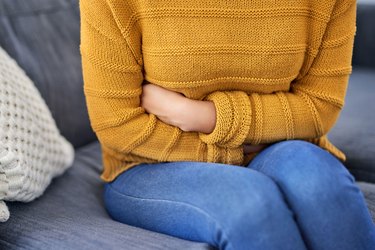
The purpose of a colonoscopy is to identify potential medical problems in the lower digestive tract early on, so appropriate preventive measures can be taken. The procedure is generally very safe, but sometimes it can have complications and create negative health consequences.
While many side effects — such as gas pains and bloating — are mild, some do require prompt medical attention. Here's what you need to know about potential colonoscopy risks.
Video of the Day
Video of the Day
Bowel Perforation During a Colonoscopy
While performing a colonoscopy, a doctor threads a colonoscope (a thin tube with a camera mounted on one end) into the lower intestine. In rare cases, the colonoscope can accidentally tear through the wall of the colon, resulting in a perforation that "causes air to escape and go into the abdominal cavity, which is bad," says John H. Ashcraft, DO, chief of colon and rectal surgery at the University of Kansas Health System in Kansas City.
This type of perforation is painful and potentially life-threatening, and it usually requires surgery to fix. The contents of the bowel could also leak out through the perforation, according to the American Society for Gastrointestinal Endoscopy, resulting in peritonitis, or inflammation of the abdominal wall. Peritonitis is usually caused by infection, according to the Mayo Clinic. Symptoms include fever, nausea, vomiting, abdominal pain and feeling thirsty, and treatment can include surgery, antibiotics or both.
Read more: How to Recover After a Colonoscopy
Abdominal Pain and Bloating After a Colonoscopy
Bloating and abdominal pain or discomfort are the most common minor complications after a colonoscopy, according to the American Society for Gastrointestinal Endoscopy. During the procedure, your doctor pumps a small amount of air into your colon to expand it. This makes it easier to thread the colonoscope into your lower digestive tract and also provides the doctor with a clearer picture of your colon and rectum.
But sometimes air remains inside your lower intestine after the doctor pulls out the scope, and that can create gassiness and bloating. You can usually get rid of the discomfort simply by moving around. You could also take an over-the-counter anti-flatulence drug containing simethicone, but walking should help you release post-colonoscopy gas faster and more effectively, says Dr. Ashcraft.
Bleeding
Some patients bleed lightly from the anus after getting a colonoscopy. "This typically happens after a polyp or mass is removed," notes Dr. Ashcraft. (If a doctor sees a polyp or mass while performing a colonoscopy, he or she will typically remove the growth at that time, as it may be precancerous.) The removal of larger polyps may result in heavier bleeding.
Although bleeding typically happens immediately after the colonoscopy procedure, sometimes it can take a few days to appear, Dr. Ashcraft says. It should stop on its own, but if you feel like you're bleeding a lot and/or the bleeding is continuous, seek medical help.
Warning
When you schedule your colonoscopy, make sure to discuss with your doctor any blood-thinning medication (including aspirin) that you regularly take. He or she will likely have you skip a few doses prior to having the procedure, so as not to cause or worsen potential bleeding.
Infection
It isn't common, but certain infections (bacterial and otherwise) can sometimes occur after a colonoscopy. These are usually linked to instruments that haven't been properly sterilized per the approved guidelines laid down by the American College of Gastroenterology and other groups. Keep in mind they're fairly rare: A study published in the journal Gut found that about 1.1 infections occurred for every 1,000 screening colonoscopies.
Postpolypectomy Syndrome
If your doctor finds a polyp during a colonoscopy, he or she may remove it in a procedure called a polypectomy by using cauterization (aka burning). If the heat goes deeper than intended, you may end up with postpolypectomy syndrome, which is marked by pain and sometimes bleeding and fever, says Dr. Ashcraft. "Usually the patient is placed on antibiotics and watched," he adds. "There may be surgery down the line."
Injuries Outside the Colon
In rare cases, a colonoscopy can result in injuries to organs that are attached to the colon, most notably the spleen. These can be serious and require immediate medical attention.
Even rarer than problems with the spleen is colonoscopy-induced appendicitis. According to an article published in the Journal of the Society of Laparoendoscopic Surgeons, only 12 instances of acute appendicitis after a colonoscopy have ever been noted in the medical literature. To put that number into perspective, some 15 million colonoscopies are performed annually in the U.S. alone, according to the Centers for Disease Control and Prevention.
- Gastrointestinal Endoscopy: "Complications of Colonoscopy"
- Mayo Clinic: “Peritonitis”
- American College of Gastroenterology: “Multisociety guideline on reprocessing flexible GI endoscopes: 2016 update.”
- Gut: “Rates of infection after colonoscopy and osophagogastroduodenoscopy in ambulatory surgery centres in the USA.”
- Journal of Community Hospital Internal Medicine Perspectives: “Post-polypectomy electrocoagulation syndrome: a rare cause of acute abdominal pain.”
- Journal of the Society of Laparoendoscopic Surgeons: "Perforated Appendicitis After Colonoscopy.”
- Centers for Disease Control and Prevention: “Colorectal Cancer Screening Capacity in the United States.”
- World Journal of Gastroenterology: "Colonoscopic Perforation: Incidence, Risk Factors, Management and Outcome"
Is this an emergency? If you are experiencing serious medical symptoms, please see the National Library of Medicine’s list of signs you need emergency medical attention or call 911.